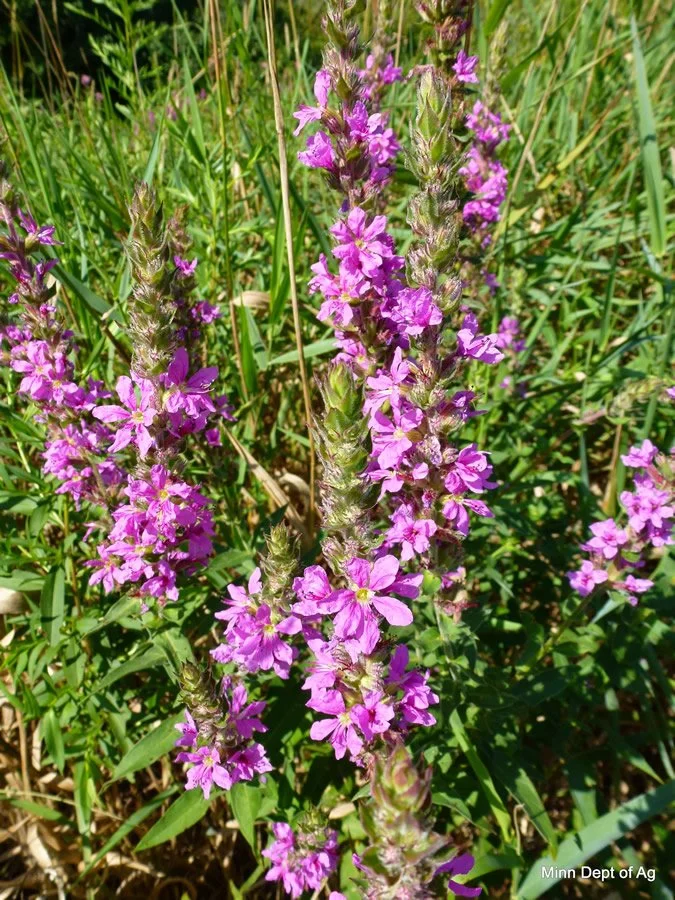Learn About Aquatic Invasive Species (AIS)
✓ AIS currently present in Big Marine Lake • † Invasive species threats • ‡ Native species.
-

✓ What is Eurasian Water Milfoil?
Eurasian watermilfoil is native to Europe and Asia. It was discovered in the eastern United States in the early 1900s. The species was likely introduced and spread through the movement of watercraft and water-related equipment. In Minnesota, it was first recorded in Lake Minnetonka (Hennepin County) in 1987.
-

† What are Zebra Mussels?
The zebra mussel is native to Eastern Europe and Western Russia. The species was unintentionally introduced into the United States’ Great Lakes through the discharge of contaminated cargo ship ballast water. They were first discovered in the Great Lakes in 1988 and found in the Duluth/Superior Harbor in 1989.
-

† What is Flowering Rush?
Flowering rush is native to Europe and Western Asia. The first discovery in North America was in the St. Lawrence River in 1897. The species was unintentionally introduced into the United States’ Great Lakes through the discharge of contaminated cargo ship ballast water. Flowering rush was found in Minnesota in 1968.
-

† What is Starry Stonewort?
Starry stonewort is native to the west coast of Europe to Japan. The species was unintentionally introduced into the United States’ Great Lakes through the discharge of contaminated cargo ship ballast water. It was first confirmed in Minnesota 2015, in Lake Koronis and Mud Lake—13 lakes in Minnesota are listed as infested with starry stonewort.
-

† What are Non-Native Phragmites?
Non-native Phragmites is native to Europe and Asia. The species was unintentionally introduced into the United States’ Great Lakes through contaminated solid ballast of cargo ships or with packing material from shipping operations. It was first discovered in the United States along the east coast in late 1700s.
-

✓ What is Curly Leaf Pondweed?
Curly-leaf pondweed is native to Eurasia, Africa, and Australia. It was likely introduced when common carp were intentionally introduced into Midwest waters as a game fish in the 1880s. The species was likely spread through the movement of watercraft and water-related equipment. It was first noted in Minnesota around 1910.
-

‡ What is Coontail?
Coontail is classified as a submerged aquatic species, meaning it grows below the surface of the water. It is a free-floating, rootless, perennial native aquatic plant that is capable of forming dense colonies covering large areas of water. The plant is found in ponds, lakes and streams across the United States, Mexico, Canada and much of the world.
-

‡ What is Water Buttercup (Crowfoot)?
Water Buttercup is a choice food source of dabbling ducks. Both the fruit and foliage are consumed by a variety of waterfowl. Water Buttercup is sometimes eaten by non-water birds such as grouse. Water Buttercup provides valuable habitat for aquatic insects and is considered a food producer for trout.
-

✓ What are Chinese Mystery Snails?
The Chinese mystery snail is native to Asia. The species is commonly imported and sold by the aquarium trade, leading to the potential for illegal release into the wild. It was brought to California in 1892 as a food source, and found in Massachusetts in 1915. Populations were first recorded in Minnesota in the early 2000’s.
-

‡ What is Northern Milfoil
Northern milfoil grows entirely underwater in depths from 1 to 20 feet. It is dark-green and has feathery leaves which are grouped in fours around a hollow stem that is usually buff- or pinkish-colored. The leaves are comprised of 5 to 10 pairs of leaflets.
-

✓ What is Narrow-Leaf Cattail?
Narrow-leaf cattail is an invasive species which takes over from native broad-leaf cattail and is so dense that it hinders fish reproduction. Minnesota Aquatic Invasive Species Research Center began a test in BML Regional Park and in 3 other Minnesota lakes on this invasive in 2021. The test objective is to determine how to reduce or eliminate the negative impact it has on fish nesting.
-
✓ What is Purple Loosestrife?
Purple loosestrife is a flowering plant which grows along shorelines and crowds out all other shoreline vegetation. It was present on BML many years ago and eradicated with the use of beetles. However, in 2022, it is back again in force.
Not a member? Join us today and put your new found knowledge to use.
